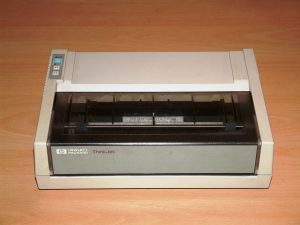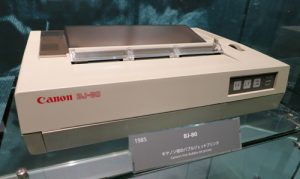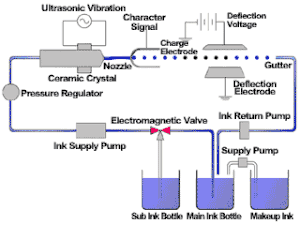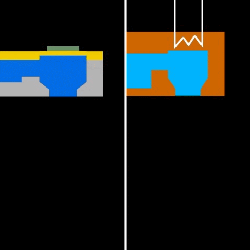Inkjet printing recreates a digital image by propelling droplets of ink onto paper or plastic substrates. It is the most commonly used type of printing technology.

Image source:
https://commons.wikimedia.org/wiki/File:ThinkJet_1984.JPG
A Milestone in Printing History
An inkjet printer can communicate with a computer of some sort and reproduce a digital image on paper, by spraying the ink on the surface. The first concept of a “drop-on-demand” inkjet printer was developed in the early 1950s, but it would take until the 1970s to reproduce digital images generated by a computer. Canon and Hewlett-Packard were competing with each other to concept the first model of this innovating technology. Ichiro Endo, who worked for Canon in Japan, invented the first thermal inkjet printer, immediately followed by John Vaught, who developed independently the model for HP. About ten years later, inkjet printers appeared on the consumer market. The challenge was to create an affordable inkjet printer without skimping on product quality. Anyway, this challenge was achieved and today this technology is widely diffused both for office and home use, making inkjet printing the most common process of printing.

(launched in December 1985)
Image source: https://www.thenimbus.co.uk/nimbus-parts-list/colourjet
Continuous Inkjet Method (CIJ)
This method is only used for commercial purposes, such as marking and coding products and packages. It was pioneered by Lord Kelvin in the late 19th century, who invented the syphon recorder, the machine can continuously record telegraph signals using an inkjet nozzle. In the 1950s Siemens introduced a device for medical patient charts. In this printer, a high-pressure pump directs liquid ink from a reservoir through a gun body and a microscopic nozzle, creating a continuous stream of ink droplets. The ink drops at regular intervals thanks to an acoustic wave, which passes through the gun body, creating a vibration. The ink droplets are subjected to an electrostatic field and are directed by electrostatic deflection plates to print on the receptor material. Anyway, only a small fraction of the droplets is used to print, the majority are recycled. This is a very high-velocity system.

Image source: https://commons.wikimedia.org/wiki/File:INKJET-PRINTER-INDUSTRI.gif Author:PT Megasatria Hiciter
Drop-on-Demand (DOD)
This method is divided into “thermal DOD” and “piezoelectric DOD”. The majority of consumer inkjet printers use the thermal process. This idea was developed by Canon and HP and is based on using thermal excitation to move tiny drops of ink. In this process a pulse of current passes through a heating element, causing the ejection of the ink from the chamber in which is stored thanks to the pressure created by a bubble of vapour. The other process is the “piezoelectric method”, which uses a piezoelectric material in an ink-filled chamber behind each nozzle. When a voltage is applied, the piezoelectric material changes shape, generating a pressure pulse in the fluid and forcing a droplet of ink from the chamber. This method allows a wider variety of inks than thermal technology but is more expensive.

Image source:
https://en.wikipedia.org/wiki/Inkjet_printing#/media/File:Micro_Piezo_Comparison.gif
Printing and Art: Giclée
This term is a neologism, used for the first time in the 1980s by printmaker Jack Duganne. Giclée originally indicated fine art digital prints made by Duganne on an Iris inkjet printer. Later Giclée was used generally to mean any fine-art, printed by different large-format printers. Artworks can be original creations or reproductions, printed in high-quality. Generally, artists use Giclée art to make reproductions of their original artwork, photographs, or digital and computer-based art. Of course, these inkjet printers specialized in images are very expensive, compared to other models.

Image source:
https://en.wikipedia.org/wiki/Gicl%C3%A9e
Info source:
https://en.wikipedia.org/wiki/Gicl%C3%A9e
https://en.wikipedia.org/wiki/Inkjet_printing#Continuous_inkjet
https://www.1ink.com/blog/the-history-of-printing/
https://castleink.com/blogs/printer-help/inkjet-printer-history
https://inventiontourblog.wordpress.com/2015/03/31/inkjet-printer-endo-invents-a-new-printing-method/
